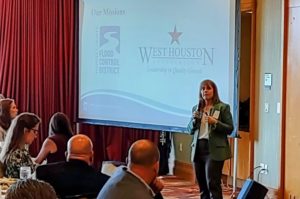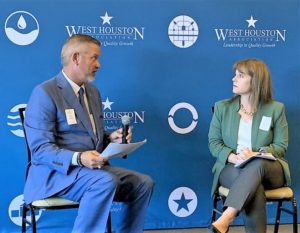 On August 4th, the West Houston Association held our 7th Annual Flood Control Forum with keynote speaker, Dr. Tina Petersen, Executive Director of Harris County Flood Control District. This was yet another sold-out event with over 150 people in attendance. Dr. Petersen began by noting that quality of life is a mission-aligned value between the West Houston Association and the Harris County Flood Control District, and that the association’s partnership is valued. As a community, protecting our watersheds and how we approach flood control and resiliency is a key component of quality of life for Harris County residents.
On August 4th, the West Houston Association held our 7th Annual Flood Control Forum with keynote speaker, Dr. Tina Petersen, Executive Director of Harris County Flood Control District. This was yet another sold-out event with over 150 people in attendance. Dr. Petersen began by noting that quality of life is a mission-aligned value between the West Houston Association and the Harris County Flood Control District, and that the association’s partnership is valued. As a community, protecting our watersheds and how we approach flood control and resiliency is a key component of quality of life for Harris County residents.
Dr. Petersen provided an update on the outcomes of the 2018 bond election that approved $2.5 billion in funding for local flood control projects. So far, the county has begun work on 181 projects across all local watersheds with another 38 projects added to that list based on community input. Meanwhile, $1.35 billion has been received in local partners’ matching funds, with a total combined spending anticipated of about $4.9 billion, overall. HCFCD will continue to pursue funding for flood resiliency efforts through potential partners funding from the infrastructure bill, annual appropriations spending, and will target the $750 million in CDBG-MIT funds.

Additionally, in the five years since Hurricane Harvey, 229 individual projects have been completed, which is valued at approximately $448 million. An estimated 14,000 homes and businesses have a reduced risk of flooding while 104.8 million cubic yards of sediment has been removed from channels. Over 2,200 people have been relocated away from flood-prone areas and community engagement has become a targeted focus for HCFCD. The Community Flood Resilience Task Force was created to bring together both experts and members of the community to bring these voices to the planning table on flood resiliency efforts. Concluding her region-wide updates, Dr. Petersen addressed the potential tunnel system project currently in Phase 3 of study and review. There are eight potential sites currently under consideration where they will likely be most effective and beneficial. At present, it is estimated that a tunnel system could avoid 80,000-120,000 instances of flooding region wide. The eight potential alignments will be refined in Phase 3 of the study. Phase 3 is getting underway and will also include an analysis of further funding sources for the estimated $30 billion project, as well as more solicited community input.
Dr. Petersen also highlighted projects more localized to the West Houston region. There are six projects in West Houston that are part of the HCFCD Frontier program, which identifies nine regional stormwater detention basins, as well as channel conveyance improvements, and actively work with developers and property owners to acquire the right-of-way ahead of development. The benefits to developers, overall, is to centralize the benefits of amenities and create standardized ponding across communities, among others. The projects in our footprint are: Little Cypress Creek Frontier, Bauer Hockley Stormwater Detention Basin, Upper Langham Creek, Clay at Grand Parkway Stormwater Detention Basin, which is anticipated to start construction in 2023, and the ongoing rehabilitation of the channels upstream of Addicks Reservoir (nearly 320,000 cubic yards of sediment removed) and Barker Reservoir (more than 170,000 cubic yards of sediment removed).
 Last but certainly not least, Dr. Petersen spoke of the importance of continued community partnerships in the advocacy efforts for funding flood infrastructure and flood planning groups. Flooding remains a top concern for residents of Harris County. HCFCD has been working in partnership with the San Jacinto Region 6 Flood Planning Group to map out the infrastructure needs to fight flooding. This work is critical to formulating a strategy and an ask of the Texas Legislature in this next session to provide significant funding to the Flood Infrastructure Fund as well as the Regional Flood Planning Groups for ongoing flood resiliency efforts statewide.
Last but certainly not least, Dr. Petersen spoke of the importance of continued community partnerships in the advocacy efforts for funding flood infrastructure and flood planning groups. Flooding remains a top concern for residents of Harris County. HCFCD has been working in partnership with the San Jacinto Region 6 Flood Planning Group to map out the infrastructure needs to fight flooding. This work is critical to formulating a strategy and an ask of the Texas Legislature in this next session to provide significant funding to the Flood Infrastructure Fund as well as the Regional Flood Planning Groups for ongoing flood resiliency efforts statewide.
As always, WHA attendees came prepared with insightful questions, which Dr. Petersen answered with an eye always to the future and collaboration. With a potential bond election coming up in November, questions returned to the tunnel study. Community input on the potential tunnel project has been an innovative process and may provide still yet more innovative ways to fight flooding. One attendee asked whether the tunnels may impact the Atlas 14 standards. While the standards will not change, tunnels are an alternative tool in a growing toolbox to fight flooding and may allow us to do things a little differently to minimize impacts to the environment. No other city has tunnels to the magnitude currently being explored by HCFCD, but both San Antonio and Washington DC have similar systems on a smaller scale. The conditions and technology have been established and proven, while the magnitude of the project is under review. Ultimately, HCFCD’s goal is to make sure that excess water has some place to go and to get there quickly. After all, flood waters know no jurisdiction or boundaries. We must think more broadly about solutions with benefits to the entire community that include industry, economic impact, and quality of life.
Community Impact also wrote an article about this forum available bellow:
Harris County Flood Control District director talks flood mitigation, funding at flood control forum
Tina Petersen, executive director of the Harris County Flood Control District, provided progress updates on 2018 bond projects and answered questions about future district efforts at a forum hosted by the West Houston Association on Aug. 4.
